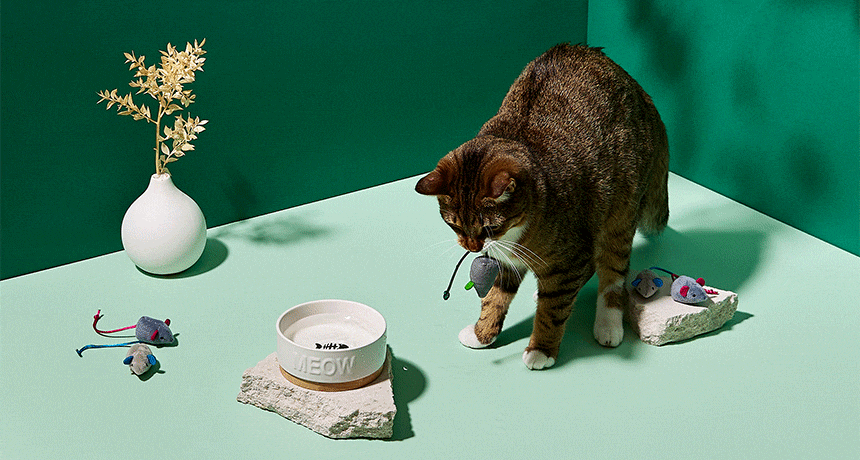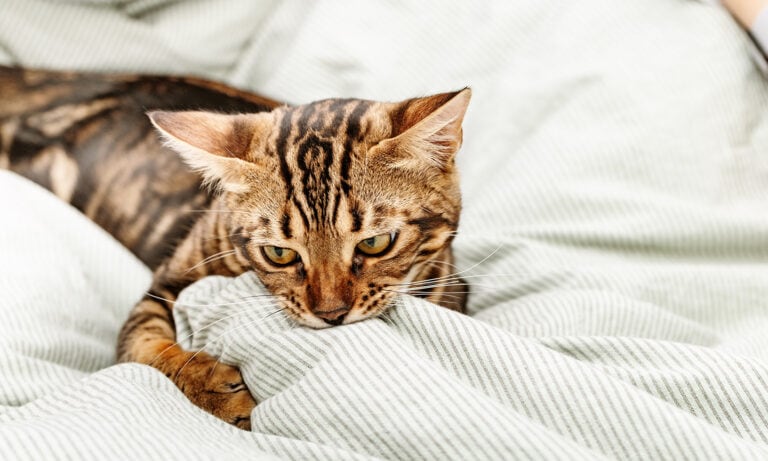Q:My cat keeps dunking her stuffed mouse in her water dish. Why do cats drown their toys? Is this normal?
A: Yes. There are a couple of possible reasons why cats drown their toys, and most of them come down to “because they’re just being cats.”
You’re barely awake after hitting the snooze button for a second time, but you’re alert enough to hear...wait, is that splashing? You sit up, wondering whether your finicky kitchen sink decided to quit its day job . But when you walk into the other room, you see your cat, looking quite pleased with herself as she repeatedly dunks one of her toys in her water dish. You think, am I dreaming or is my cat trying to drown her toy?
Since cats may consider their toys their prey, yes, they may actually be tapping into their wild cat instincts and drowning their prey. Or they may simply be having a little bit of fun in their water bowl. We spoke with cat behaviorists to get the lowdown on why cats drown their toys.
Why Cats Drown Their Toys
Let’s talk about those killer instincts first.
“There are some kinds of cats that actually do drown their prey,” says Dr. Marci Koski a certified feline behavior and training consultant with Feline Behavior Solutions in in Vancouver, Washington . “Tigers love going into water, and it’s not unusual for them to drag their prey in with them.” She also notes that there is a wild breed of cat called the fishing cat, who actually hunts fish and aquatic animals. “ However,” she says, “the vast majority of cats, including our little domestic house kitties, are not typically aquatic predators.”
OK, so if they’re not trying to drown their toy (aka prey), then what are they doing?
What many cats, regardless of their size or species, have a tendency to do is carry their toys to whatever they consider to be their own personal territory–“where they spend a majority of their time, or to a place where they feel safe,” says Beth McGonigal, CBCC, CPDT, of North Pittsburgh Animal Behavior. And that safe place just may be their food station.
“Most cats would associate their prey-based toys with food, and choose to ‘collect’ them near their food and water dishes,” McGonigal explains.

Cats may even intend to drop those toys—their “ prey”—into their food bowls, but they accidentally fall into their water dishes instead, Dr. Koski says.
“And then the cat might learn that it’s kind of fun,” she continues. “They’ll think ‘This little mouse toy floats, it bounces if I hit it, and... oh my goodness, this is interesting!’ It becomes a fun little game, or a stimulating form of play for them—they’re not necessarily trying to further ‘drown’ the toy.”
(And if we watch our cats do this, or if we laugh or give them positive attention, then McGonigal suggests that they might be prompted to keep “ drowning ” their toys just because they like the response that they’re getting.)
Should You Be Worried?
While Dr. Koski says she didn’t believe the behavior itself was problematic, she does advise keeping an eye out to ensure that the toys-in-the-water-dish situation isn’t keeping your cat from actually drinking water during the day. She also recommends keeping a cat’s food and water dishes separate from each other, if only because that’s how they may instinctively prefer things. (A wild cat would not put the prey they just caught near their water source because it could contaminate their water supply, she explains.)
“I would recommend always having more than one water source for cats in the home, and I also recommend fountains—a lot of cats do really like running water,” she says. (Read more about cat's fasciation with running water here.) “If you only have one water dish, and toys are constantly ending up in it, that might present a cleanliness issue, which could discourage your cat from drinking out of that dish.”
If you don’t enjoy wiping water off the floor several times a day, McGonigal recommends switching to “toys that do not resemble prey animals,” like feather chasers, puzzles, or string-based toys. If you’re cool with your cat continuing with their water-play, you could place a silicone mat under their bowl to collect any spills and splashes.
“Or you might encourage this style of play at certain times, when you’ve prepared for it,” Dr. Koski adds. “There are little swimming fish you can put in a sink or a tub, or you can put ice cubes in a bowl of water for them to bat around. They can still have the same kind of engagement and stimulation, but you’ll be ready for it.”
The only downside? The next time you hear mysterious splashes coming from some other part of the house, it might not be the cat!
Share:









